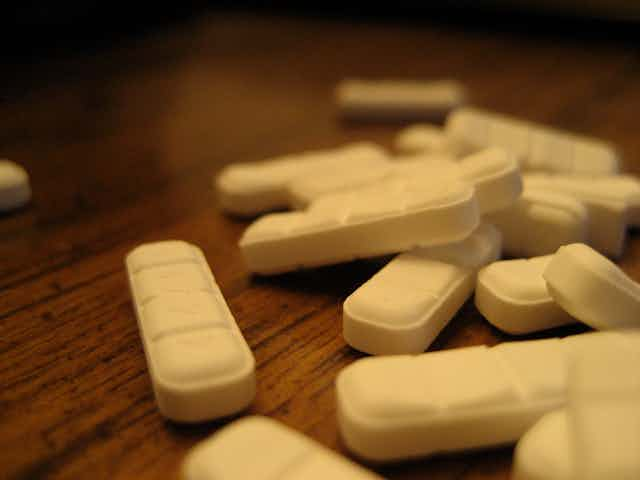More teenagers and young people use drugs than any other age group: in 2017, 16.5% of 16- to 19-year-olds and 21.2% of 20- to 24-year-olds across England and Wales said they had taken drugs in the past year. And although drug use has declined over the past decade, new and potentially life-threatening trends continue to appear. Most recently, doctors have warned of an “emerging crisis” relating to Xanax use among young people.

Xanax is a brand of alprazolam – a benzodiazepine drug, or “benzo” – which is marketed as an alternative to Valium (diazepam) and used to treat anxiety, panic attacks and problems associated with depression. It works by affecting the way that the brain functions, to increase feelings of pleasure and reduce stress and anxiety.
Doses range from 0.25mg to a maximum of 3mg per day (by comparison, a teaspoon of sugar is about 1,300 times this amount). A dose can take up to an hour to have an effect, which then typically lasts for between five and 12 hours, depending on the formulation of the drug. It can take four or five days to clear the drug from the body.
Here to stay
While it is the most frequently prescribed benzodiazepine in the US, Xanax is not available in the UK, but it can be obtained on private prescriptions and online. Recent data suggests that the UK is the second largest market for Xanax on the dark web, after the US. Its widespread availability on the internet has made the situation around this drug especially perilous.

To be clear, there is no such thing as a “safe” drug. A drug – whether swallowed, smoked, inhaled, injected – is going to have an effect on the physiology and, potentially, the mental state of the person who takes it. Every person is different, and will react differently to different drugs, doses and ingredients. It is never clear exactly what is actually in the recreational drugs that people take which is why we should be so concerned about the effects that they might have.
But we can’t pretend that recreational drugs are going to go away. People have used drugs for thousands of years; whether for religions reasons, as a way of life, due to peer pressure, to experiment, or to escape from reality. Some are legal, while others carry severe fines, prison sentences or penalties as harsh as the death sentence in some parts of the world. People will use drugs such as Xanax regardless of legal controls, so it’s best to be clear how it works, and why it presents a health risk.
When people use Xanax regularly, they build up a tolerance to the drug, which means they need to take larger and more frequent doses for the drug to have the desired effect. Eventually, this results in a physical dependence – where the brain needs the drug to function “normally”. People can also develop a psychological dependence – they feel like they “need” the drug. Together, these effects lead to what we understand as addiction.
Know the risks
If someone becomes addicted to prescription drugs, including Xanax, then the effect of the drugs has to be reversed - normal functioning of the brain cells must be restored and this is a long, slow and often painful process. Under the influence of the drug, there are side effects – apathy, sleepiness, decreased cognitive functioning, as well as the possibility of slurred speech or violent outbursts.

Like any other benzodiazepine drugs, Xanax should not be taken with alcohol. This can increase the drug’s effects, potentially leading to loss of consciousness and coma. What’s more, Xanax levels could build up in the body, which increases the chance of an overdose the next time the drug is taken. All of these effects present risks to the user’s health, or to their livelihood and future aspirations.
The drug market contains products manufactured legally and illegally. Some drugs are diverted onto the black market from legal pharmaceutical sources, while others are powders imported from overseas and pressed into tablet form. In our work as forensic chemists, we have seen this with many other drug types over the years through our casework and research on MDMA, piperazines and cathinones. There is always a risk that the drug in the powder is not what it seems – even if the pill looks legitimate.
Drugs which are legally manufactured and sold undergo quality control procedures - for example controlling the amount of drug in each pill and its purity. On the black market, these processes are completely missing. Most users can’t determine the materials and processes used to make illegal drugs, so there is no way of knowing the toxicity of the drugs or of the chemicals made from the side reactions of the drug making process.
Drug testing kits are available on the internet, but at best, these will only tell you the group of drugs that a pill may contain - not which of the many possible drugs are present. They won’t accurately tell you how much drug is present, or how the drug was made or what impurities the pill might contain. Some employers use drug testing in the workplace: these tests are accurate, and employees who test positive for drugs often face dismissal. The best way to avoid the risks associated with recreational drugs is to avoid taking them altogether.

